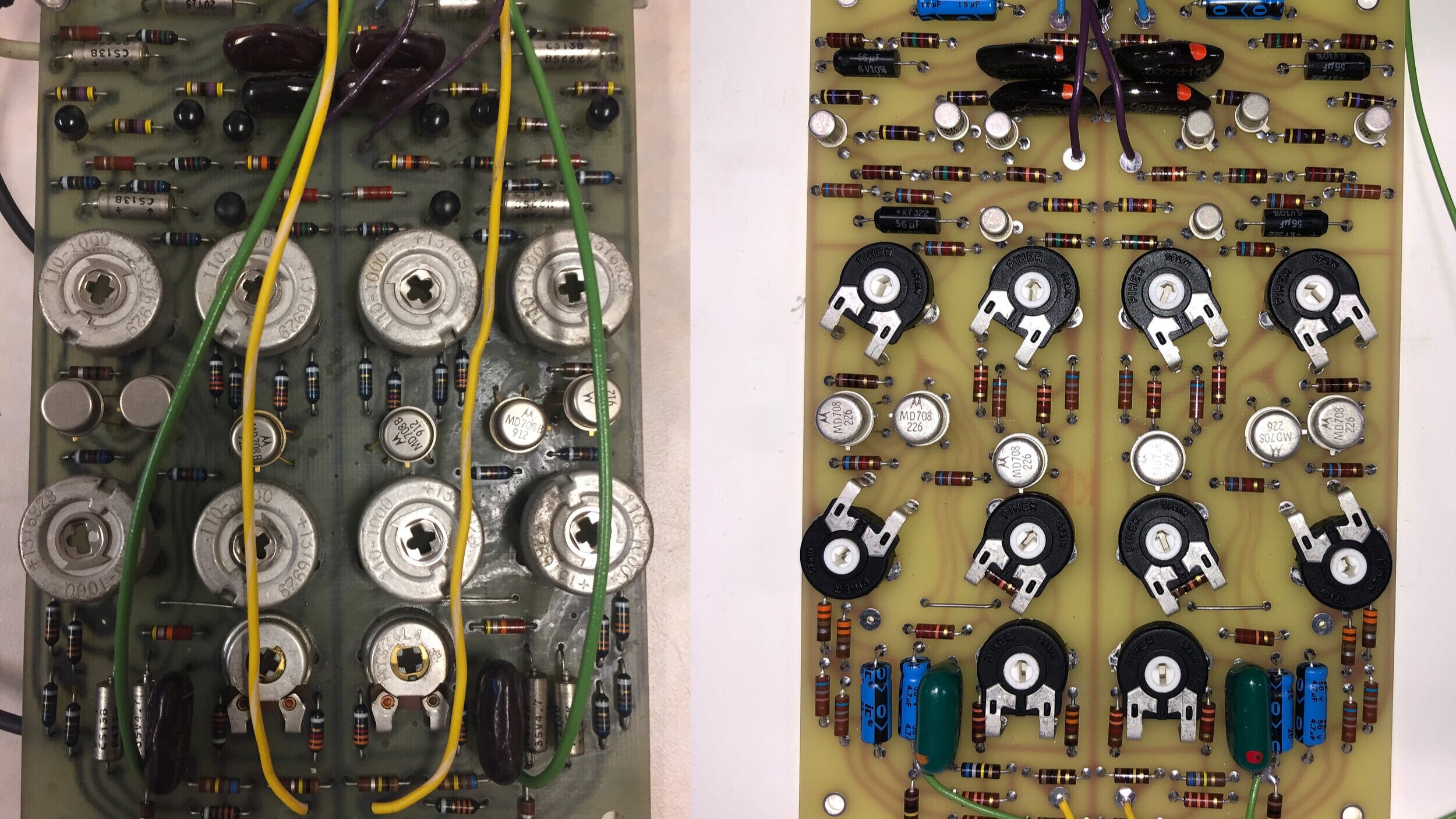THE M.E.M.S. PROJECT
M.E.M.S.
Schematic for the 148 Harmonic Generator with the inspiration for the M.E.M.S. title.
Modular Electronic Music Systems
The MEMS Project came to fruition out of shared frustration. For decades, the Buchla 100 Series system has remained elusive and unavailable to academic scrutiny. Over the years, as systems were parted out and sold to private collectors, the number of complete and functional systems have dwindled down to a state of scarcity. What was once an invaluable educational instrument, has now been reduced to mere photos and sources of hearsay on the internet, as if it were an electronic cryptid of sorts that remains a myth to those that were not in the right place at the right time.
Like most legends, the story changes as time digests it. There needs to be a suspended animation on the decay of these modules, and if students are to study something, why not study a perfect analogue of the original? The focus is to preserve the old systems yet learn from it in a new way.
M.E.M.S. is currently reverse engineering modules and making period accurate replicas, from the ground up. The original boards are hand traced, scanned, and then retraced in CAD software to translate the board layouts to gerber files, so fabrication can be achieved. Period accurate parts are used when available to emulate the circuit to the best of our abilities.
Detail of CBS 111 Dual Ring Modulator (left) and M.E.M.S. replica (right)
M.E.M.S. Origins:
Chip Flyinn measuring a 112 Touch Controlled Voltage Source panel at University of Michigan
University of Michigan
Initially, the project set its sights on reverse engineering and restoring a CBS era Buchla 100 system housed at University of Michigan. This began in the early months of 2018 as a precursor to M.E.M.S. The system was part of the Stearns Collection and was in various states of disrepair. It was apparent that reliable documentation was needed, since very little of it still exists. What was available in terms of schematic data was rudimentary; it was poorly Xeroxed and riddled with erroneous parts values, either the direct result of poor record keeping by CBS (which CBS was notorious for), or possible deliberate red herrings left by Don Buchla when the company was sold off to CBS at the end of the 1960s.
We were concerned that this deterioration of information would continue and cause a wealth of data to disappear from the grasp of future generations, save for the few people that possess original schematic drafts. There is a lot to learn from Don Buchla’s designs, and these insights can be utilized in the creation of new instruments.
The project was officially christened at the beginning of September 2018, when Mark and Chip finally met online through a mutual friend, Mike Peake.
Chip Flynn and the Stearns Collection system 100
M.E.M.S.
Mark Milanovich working on deciphering the Tudor collection at Wesleyan University, 09/23/2019
Destinations
So where will this project take us? The aim of this research has always been to ford the rivers of academia and giving students a window into the history of Buchla. This became a reality when we were invited to Wesleyan University in September of 2019, a momentous occasion to mark the year anniversary of the project’s conception.
The documentation of David Tudor’s 113 Touch Controlled Voltage Source and 120 Voltage Controlled Distributor took place over a grueling 12 hour visit and lecture that we delivered to Ron Kuivila’s Compositions class.
This is the experience that the project wishes to perpetuate. The project has reached the 70s and beyond, and is well into documenting 200 Series modules, along with some 300 series versions. Hopefully these discoveries will shed some light onto what lines up with the current clones and what sets them apart, in order to bring to light the true sound of Buchla.
Lecture setup, shown with prototype demo system. Adzenyah Rehearsal Hall, Wesleyan University, 09/23/2019
Don Buchla:
Don Buchla and the 100 series
The Stoic Genius
Don Buchla was a self-propelled designer that refused to dwell on the past. Many people could consider this a symptom of the times, in terms of exponential advancements happening in Silicon Valley. While we believe this to be the case, we also subscribe to the belief that Don could not dwell on the past because he could simply not afford to. Don was extremely adept at compartmentalizing his thoughts and weeding out what was and wasn’t useful to him at that moment in time. Many innovators share this characteristic, which is why it is very important to note that behind a fast and efficient inventor, must be a slower, more methodical record keeper. If a creator dwells on the past, opportunities to pave the future are limited.
This is the momentum that pushes this project. To document, reverse engineer and outline Don’s work from a stance of complete transparency.
This project is dedicated to Don Buchla and all of the Associates that played an instrumental part in assembling the future of electronic composition.







